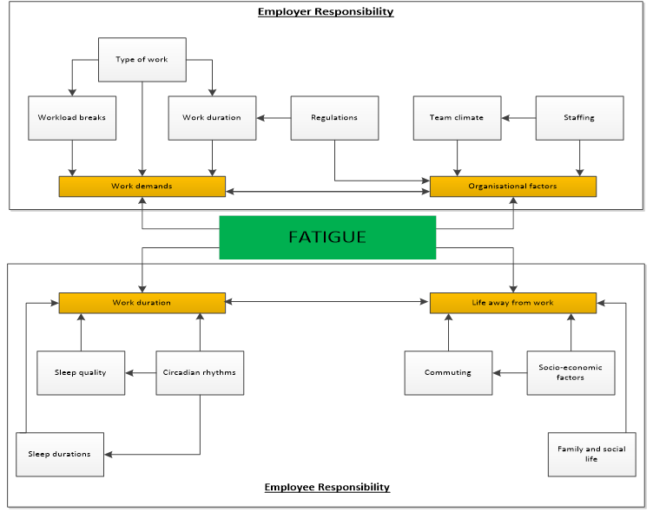Dr Karen McDonnell, Head of the Royal Society for the Prevention of Accidents Scotland and RoSPA Occupational Health and Safety Policy Adviser, spoke at The Health and Safety at Work Conference, January 2021 [1]. This article will look at the impact of fatigue and how to manage fatigue at work both as an employee and employer.
Fatigue and its Impact
Fatigue is a major risk factor leading to accidents in the workplace, however, it continues to be under-recognised; it must be taken seriously as it can have devastating effects.
For example, following a collision, while driving a Carillion Rail Resourcing crew van that killed 3 people, Stephen Parry Jenkins was jailed for four and a half years and banned from driving after getting behind the wheel ‘knowingly deprived of sleep or rest’ [1].
As we return to the workplace those who have been working from home will begin their commute into work again, many of them driving. Fatigue while driving cause up to 20% of road accidents, 25% of which are fatal [2].
The risk between driving and lack of sleep are closely related, as demonstrated by statistics collected by RoSPA. Having 6 to 7 hours sleep, compared to the recommended 7 to 9, increases the crash risk by 130 %. Comparatively, 4 to 5 hours sleep increases the crash risk by 430% and less than 4 hours sleep to 11.5 [3].
So, How Can We Manage Driving Fatigue?
It is both the employee’s and employer’s responsibility to manage fatigue. A good place to start is Rule 91 of the Highway Code. This rule states that before setting off you must make sure that you are fit to drive, while also recommending that you avoid undertaking long journeys between midnight and 6.00 am. It is suggested that you take a minimum of one 15-minute break after every two hours of driving. Finally, if you do find that you are tired you must stop in a safe place, they recommend that you have two cups of caffeinated coffee and take a 15-minute nap [1].
Karen expanded on these suggestions, incorporating procedural recommendations for the workplace [1]:
- 12 Hours Door to Door – Shift times to be capped at a maximum amount of 12 Hours Door to Door and 12 hours of minimum rest between shifts
- No more than 13 in 14 – Workers should not work more than 13 Shifts in 14 Days
- No more than 300 miles or 3 Hours – Employees should drive no more than 300 miles per shift, taking breaks after 2 hours and not driving more than 3 hours in one day
- Local Lodgings - if it’s more than a 1-hour journey to the worksite and it is over the maximum of 12 Hours Door to Door
- No Blame Culture – Blame or punitive measures should not be taken against a driver who either stops to rest or reports unfit for work due to tiredness

Managing the Risk of Driver Fatigue as an Employer
Following the above recommendations, it is important that employers ensure their employees are informed of the risks associated with fatigue. It is the employer’s responsibility to ensure working hours, shift rosters, shift changeovers, and shift cycles are structured and managed to avoid or minimise fatigue, including scheduled breaks. RoSPA believes it is up to the employer to implement every practicable control measure that can reduce the effects of fatigue [1].
Managing the Risk of Driver Fatigue as an Employee
While it is up to the employer to ensure they implement every measure they can to reduce fatigue, it is the individual’s responsibility to ensure they do not put other people in danger by undertaking a duty when they are excessively fatigued. It is the employee’s responsibility to inform their line manager as soon as possible if they believe that they or a colleague are likely to become too tired to carry out duties safely. This includes factors such as, illnesses or second jobs, which could affect fatigue and/or the ability to carry out duties safely.
Additionally, individuals must manage their personal time to ensure they are rested and fit for duty; this includes taking future duty times into account when planning off-duty lives. It is important to ensure that sleeping environments, nutrition, use of caffeine, alcohol, drugs and medications, and travel arrangements do not adversely affect the ability to carry out duties safely.
We all have a responsibility to adopt a balanced approach to health, safety and risk. The best place to start is conversations! Karen recommended the Scottish Occupational Road Safety Alliance’s free information and advice, as well as one to one support, to raise employers’ awareness of the need to Manage Occupational Road Risk [4]. RoSPA also provides road safety factsheets on driver health, fatigue and road accidents and planning journeys [5].
Sources:
[1] McDonnell, K. 2021. The Health and Safety at Work Conference 2021
[2] rospa.com. 2020. Road Safety Factsheet. [online] [Accessed 18/05/21]
[3] sciencedaily.com. 2016. Missing 1-2 hours of sleep doubles crash risk. [online] [Accessed 18/05/21]
[4] scorsa.org.uk
[5] rospa.com. Free Resource. [online] [Accessed 18/05/21]
Register FREE to access 2 more articles
We hope you’ve enjoyed your first article on GE Insights. To access 2 more articles for free, register now to join the Government Events community.
(Use discount code CPWR50)




